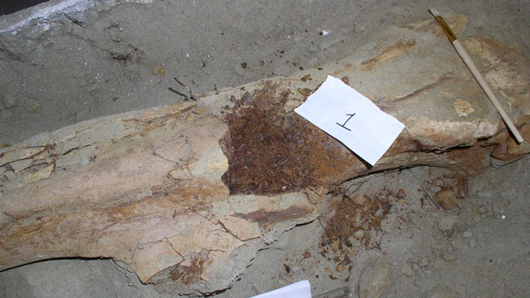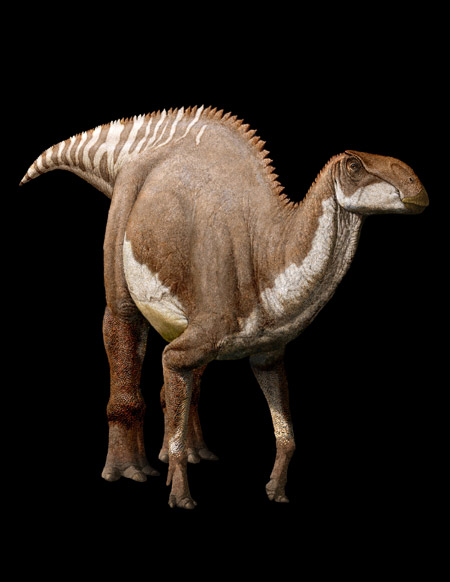Researchers in New Study Confirm Dinosaur Collagen
2009 Brachylophosaurus Study Replicated
One of the most controversial areas of palaeontology is the extraction and assessment of traces of organic remains preserved in the fossil record. Indeed, the study of preserved proteins and other organic remains such as potential red blood cells from within fossils tens of millions of years old, is perhaps, one of the most controversial subjects in the whole of science.
Researchers from North Carolina State University, eminent figures such as Professor Mary Schweitzer have been at the very forefront of this relatively new area of study, essentially long extinct animal molecular biology. Organic material from fossils of dinosaurs is being reported more frequently, however, being able to repeat analyses and confirm previous results remains fundamental to the results of such studies gaining acceptance in the wider scientific community.
Studying Dinosaur Fossil Bone
A new paper has been published in the “Journal of Proteome Research” by scientists from North Carolina State University who, in collaboration with colleagues from North-western University and the University of Texas – Austin, have applied the most rigorous testing methods used to date to isolate additional collagen peptides from an 80-million-year-old dinosaur thigh bone. This study helps strengthen the idea that organic molecules can persist within the fossil record for many millions of years.
Repeating an experiment and replicating previous results has implications for our ability to study the fossils of long extinct creatures at the molecular level. The job of “dinosaur biologist” may have come one step closer.
The Brachylophosaurus (B. canadensis) Femur
Picture credit: North Carolina State University
Dinosaur Femur Used in the Study
The picture above shows the dinosaur thigh bone used in the study. The area for sampling has been marked on the bone, demonstrating that not everything within this cutting-edge form of palaeontology is that sophisticated.
North Carolina State postdoctoral researcher Elena Schroeter, along with Professor Mary Schweitzer and co-worker Wenxia Zheng wanted to confirm the results of an earlier (2009) assessment of organic material retrieved from the femur of a duck-billed dinosaur (Brachylophosaurus canadensis). Advances in mass spectrometry and clean room technology since the first experiments, would permit the team to produce a more robust set of results, with less risk of contamination or false “positive” results.
Explaining the team’s reasoning for repeating the 2009 study, Elena Schroeter stated:
“Mass spectrometry technology and protein databases have improved since the first findings were published, and we wanted to not only address questions concerning the original findings, but also demonstrate that it is possible to repeatedly obtain informative peptide sequences from ancient fossils.”
The Hunt for Collagen
Collagen is a protein, it forms fibrous strands and, ironically it happens to be the most abundant protein found in our own bodies. The proteins that make up collagen are themselves composed of peptides, which are chains made up of amino acids. If peptides can be identified within a dinosaur bone (or any fossil bone for that matter), palaeontologists will be able to determine the evolutionary relationships between members of the Dinosauria and their relationship with extant animals.
This would help solve such puzzles as whether or not the dinosaurs were warm-blooded and provide much more information about the lives of these long extinct animals, far more information than could be derived from an anatomical analysis of preserved bones and teeth. In addition, this type of study would help to answer other intriguing questions. related to the fossilisation process itself. For example, which characteristics of collagen proteins permit preservation over deep geological time?
Brachylophosaurus canadensis
Brachylophosaurus was a member of the Hadrosauridae family of bird-hipped dinosaurs (ornithischians) and it is known from relatively abundant (bonebed) fossil material excavated from Upper Cretaceous deposits of North America (Judith River Formation of Montana, USA and the contemporaneous Oldman Formation of Alberta, Canada). This herbivorous dinosaur lived some 80-78 million years ago, (Campanian faunal stage of the Late Cretaceous). It was formally named and scientifically described in 1953.
The Late Cretaceous Duck-billed Dinosaur Brachylophosaurus canadensis
Picture credit: Houston Museum of Natural Science
For models and replicas of hadrosaurs and other ornithischian dinosaurs: CollectA Prehistoric Life Figures.
Professor Schweitzer commented:
“We collected B. canadensis with molecular investigation in mind. We left a full metre of sediment around the fossil, used no glues or preservatives and only exposed the bone in a clean, or aseptic environment. The mass spectrometer that we used was cleared of contaminants prior to running the sample as well.”
Specimen Number MOR 2598
The sample of bone that was analysed was from the specimen’s femur (thigh bone). The bone used was specimen number MOR 2598. Using mass spectrometry, the team recovered a total of eight peptide sequences that form collagen (collagen I). Two peptide sequences were identical to those recovered in the 2009 research, six are new, not having been found in previous studies. The peptide sequences show that the collagen in a dinosaur (B. canadensis) has affinities with extant Aves (birds) and crocodylians, a result expected given the close phylogeny between the Dinosauria and these two groups.
Elena Schroeter added:
“We are confident that the results we obtained are not contamination and that this collagen is original to the specimen. Not only did we replicate part of the 2009 results, thanks to improved methods and technology, we did it with a smaller sample and over a shorter period of time.”
Phylogenetic Affinity
Phylogenetic analyses place the recovered sequences within basal Archosauria and when only the six new sequences are considered, B. canadensis is grouped more closely to crocodylians. However, when all sequences (current and those reported in 2009), are analysed, B. canadensis is placed more closely to stem Aves. The researchers conclude that their data robustly supports the hypothesis of an endogenous origin for these peptides, (they originated from within the organism’s bone), confirming the idea that peptides can survive in specimens tens of millions of years old, and being able to repeat the experiment and obtain the same results bolsters the validity of the earlier (2009) study.
Professor Schweitzer, a stalwart for organic molecular research in the fossil record explained:
“Our purpose here is to build a solid scientific foundation for other scientists to use to ask larger questions of the fossil record. We’ve shown that it is possible for these molecules to preserve. Now, we can ask questions that go beyond dinosaur characteristics. For example, other researchers in other disciplines may find that asking why they preserve is important.”
Testing a Hypothesis
Although this research remains controversial, there is a growing body of evidence that suggests the minute traces of organic matter can be preserved within the fossil record. In order for this research to gain wider acceptance it must be shown that peptide sequences can be reliably obtained from fossil material and that these experiments can be repeated with the same outcomes. Intriguingly, as our ability to identify organic molecules improves, so these highly fragmentary sequences for ancient proteins can be increasingly expanded.
To test the hypothesis that peptides can be repeatedly detected and validated from fossil tissues many millions of years old, the research team applied updated and more sophisticated extraction methodology, in conjunction with improved sterile, clean-room conditions.
Eight Peptide Sequences Identified
High resolution mass spectrometry and bioinformatics analyses on a Brachylophosaurus canadensis specimen (MOR 2598), from which collagen I peptides were recovered in 2009, led to the identification of eight peptide sequences in the repeated experiment. This new study further augments the idea that within fossilised elements, which, perhaps have been preserved under exceptional conditions, do indeed, contain minute organic remnants of long dead organisms.
To read a related article about the potential for finding blood remnants with dinosaur fossils: The Blood of a Brachylophosaurus.
The scientific paper: “Expansion of the Brachylophosaurus canadensis collagen I sequence and additional evidence for the preservation of Cretaceous protein”.
Authors: Elena Schroeter, Mary Schweitzer and Wenxia Zheng, NC State University; Caroline DeHart, Paul Thomas, Neil Kelleher, North-western University; Timothy Cleland, University of Texas-Austin; Marshall Bern, Protein Metrics. Published: Journal of Proteome Research.
Visit Everything Dinosaur’s award-winning website: Everything Dinosaur.



